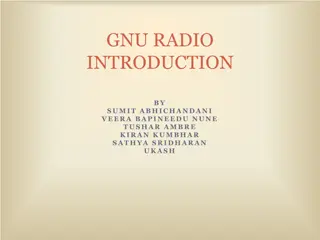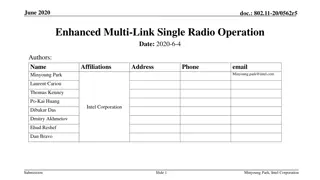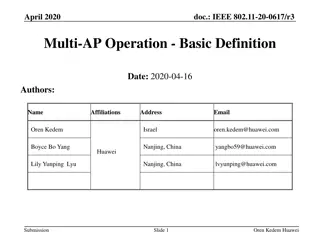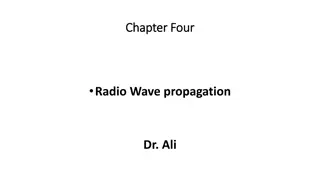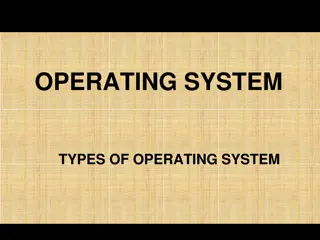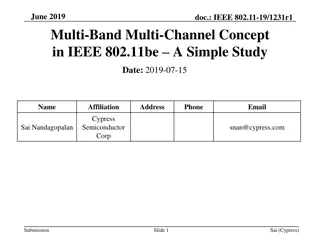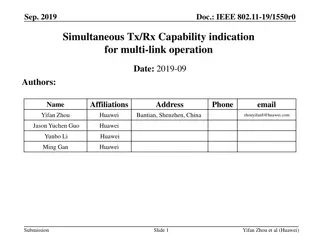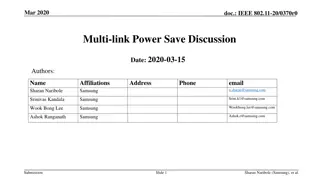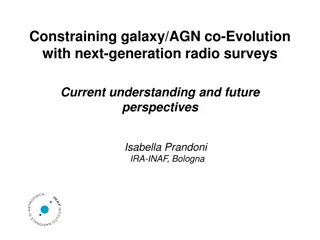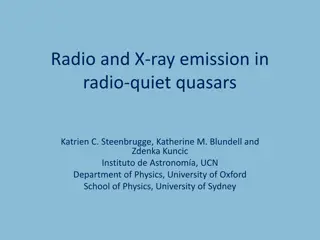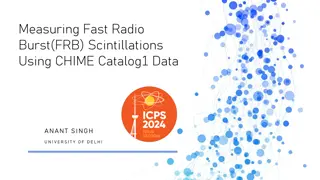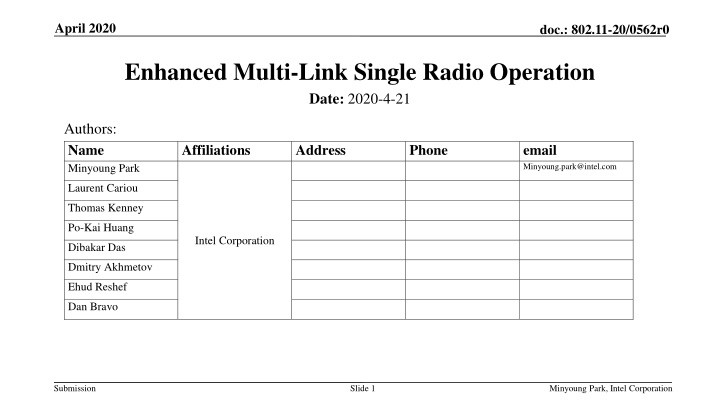
Enhanced Multi-Link Single Radio Operation Proposal
Explore the proposal for enhanced multi-link single radio operation in busy network environments, aiming to boost throughput and reduce latency with innovative technologies. Learn about the advantages and challenges of single-radio operation and how it can compete with dual-radio setups.
Download Presentation

Please find below an Image/Link to download the presentation.
The content on the website is provided AS IS for your information and personal use only. It may not be sold, licensed, or shared on other websites without obtaining consent from the author. If you encounter any issues during the download, it is possible that the publisher has removed the file from their server.
You are allowed to download the files provided on this website for personal or commercial use, subject to the condition that they are used lawfully. All files are the property of their respective owners.
The content on the website is provided AS IS for your information and personal use only. It may not be sold, licensed, or shared on other websites without obtaining consent from the author.
E N D
Presentation Transcript
April 2020 doc.: 802.11-20/0562r0 Enhanced Multi-Link Single Radio Operation Date: 2020-4-21 Authors: Name Minyoung Park Affiliations Address Phone email Minyoung.park@intel.com Laurent Cariou Thomas Kenney Po-Kai Huang Intel Corporation Dibakar Das Dmitry Akhmetov Ehud Reshef Dan Bravo Submission Slide 1 Minyoung Park, Intel Corporation
April 2020 doc.: 802.11-20/0562r0 Introduction 11be non-AP MLDs are expected to have different capabilities for multi- link operation and many non-AP MLDs are expected to operate with a single radio It is important to enable a multi-link operation for a single radio non-AP MLD that can provide throughput enhancement and latency reduction close to a concurrent dual radio non-AP MLD In this presentation, we propose an enhanced multi-link single radio operation that can achieve this goal Submission Slide 2 Minyoung Park, Intel Corporation
April 2020 doc.: 802.11-20/0562r0 Problem: Multi-link operation using concurrent dual- radio in a busy network environment Reality: Channel 1 and Channel 2 busy (due to overlapping networks) Long delay if single radio Ideal case: Channel 1 and Channel 2 idle (no overlapping networks) AP AP STA STA (Concurrent dual radio) (Concurrent dual radio) (Concurrent dual radio) (Concurrent dual radio) data packet busy Radio 1 Radio 1 Radio 1 Radio 1 Channel 1 Channel 1 Low latency busy Radio 2 Radio 2 Radio 2 Radio 2 Channel 2 Channel 2 As network gets busier, there is less chance to have two (or multiple) idle channels at the same time In this case, most of time just one of the two channels will be used for data transfer This is effectively a single channel operation but switching between the two channels In a busy network, concurrent dual radio can still provide low latency benefit compared to single radio since AP can transmit a packet on any channel when the medium is idle Max peak throughput gain of concurrent dual radio can be achieved when two channels are idle In a busy network environment, concurrent dual-radio doesn t provide full benefit of STR Slide 3 Submission Minyoung Park, Intel Corporation
April 2020 doc.: 802.11-20/0562r0 Proposal: Enhanced Multi-link Single Radio (MLSR) Operation We propose an enhanced mode of operation for a single radio non-AP MLD where Single-radio non-AP MLD listens to two (or more) pre-configured channels simultaneously 2x2 Tx/Rx module may be configured to 1x1 on each channel/band (e.g. 5GHz and 6GHz) to listen to incoming packets on each channel 1x1 STA on one channel may add an extra 1x1 Rx on the other channel and listen to two channels for incoming packets AP MLD transmits a control frame (e.g. RTS or MU-RTS) on any idle channel of the pre-configured channels before a data frame transmission The control frame indicates to non-AP MLD which channel will be used for data transmission Upon reception of the control frame, non-AP MLD responds with a control frame (e.g. CTS) Data transmission follows the response from the non-AP MLD Non-AP MLD and AP MLD exchange frames on one link at a time Concurrent Dual Radio Proposal: Enhanced Multi-link Single radio STA AP Long delay if single radio AP STA (single radio) (Concurrent dual radio) (Concurrent dual radio) (Concurrent dual radio) busy D D D D busy 1x1 Radio 1 1x1 on ch1 Radio 1 Radio 1 Radio 1 for data reception Channel 1 Low latency Channel 1 Low latency R R 2x2 on ch2 1x1 Radio 1 1x1 on ch2 D D D D busy Radio 2 Radio 2 Radio 2 Channel 2 Channel 2 C C A Channel switch signal (RTS) Submission Slide 4 Minyoung Park, Intel Corporation
April 2020 doc.: 802.11-20/0562r0 Network Simulation Setup Configuration Target BSS: 4 OBSSs: OBSS traffic load on each band: 10-90% of 1x1, 80MHz, MCS0 PHY rate (36Mbps) on each band This is an example configuration that models channel occupancy due to OBSS (e.g. 10% load generates 3.6 Mbps traffic load and occupies approximately 10% of airtime) RTS/CTS enabled Comparisons: SLSR: Single-link, single-radio MLMR: Multi-link, multi-radio (concurrent) MLSR: Enhanced multi-link, single-radio (use RTS for channel switch signal) Throughput evaluation: Backlogged traffic on the target BSS (DL), simulation time: 10 sec, 6 times End-to-end latency evaluation: 512 byte packet every 20 msec, simulation time: 20 sec, 1 time 1 AP, 1 STA, 2 bands/channels 2x2, 80MHz, MCS0/4/7, max TXOP = 5msec 1 AP, 2 STAs each One STA on each band/channel 1x1, 80MHz, MCS0 Submission Slide 5 Minyoung Park, Intel Corporation
April 2020 doc.: 802.11-20/0562r0 Throughput results 80MHz, 2x2, MCS4 Enhanced multi-link single-radio achieves 60-70% throughput enhancement in a busy network (OBSS load : 40-70%) Enhanced multi-link single-radio reaches 70-80% of the multi-link multi-radio throughput in a busy network (OBSS load >30%) Submission Slide 6 Minyoung Park, Intel Corporation
April 2020 doc.: 802.11-20/0562r0 Throughput results for lower MCS 80MHz, 2x2, MCS0 Results follow similar trend as the MCS4 case Enhanced multi-link single-radio achieves 60-70% throughput enhancement in a busy network (OBSS load : 40- 70%) Enhanced multi-link single-radio reaches 70-80% of the multi-link multi-radio throughput in a busy network (OBSS load >30%) Submission Slide 7 Minyoung Park, Intel Corporation
April 2020 doc.: 802.11-20/0562r0 Throughput results for higher MCS 80MHz, 2x2, MCS7 Results follow similar trend as the MCS0 and MCS4 cases Enhanced multi-link single-radio achieves 60-70% throughput enhancement in a busy network (OBSS load : 40- 70%) Enhanced multi-link single-radio reaches 70-80% of the multi-link multi-radio throughput in a busy network (OBSS load >30%) Submission Slide 8 Minyoung Park, Intel Corporation
April 2020 doc.: 802.11-20/0562r0 Latency results In a very busy network, the proposed enhanced multi-link single radio approach reduces the end-to-end latency by half compared to single-link single radio worst case latency improvement The latency performance of the proposed method is similar to the multi- link multi-radio case 90%tile e2e latency measurement OBSS load 80% 90% SLSR 73ms 84ms ~half MLMR 32ms 38ms MLSR 32ms 39ms Submission Slide 9 Minyoung Park, Intel Corporation
April 2020 doc.: 802.11-20/0562r0 Enabling the proposed MLSR operation with minimal changes in 802.11be Non-AP MLD s behavior Indicates that it is Single-Radio non-AP MLD to its intended transmitter or receiver (i.e. AP MLD) Single-Radio non-AP MLD is unable to transmit or receive frames on more than one link simultaneously Enable two or more links Initial power states: one link is in the awake state and the rest are in the doze state Enable the dynamic SM power save for the two or more enabled link HE dynamic SM power save may need to be extended to EHT dynamic SM power save with additional constraints (e.g. supported MCS, bandwidth, frame types (e.g. RTS, MU-RTS, Trigger, etc.)) To enable the MLSR operation, the non-AP MLD indicates two or more enabled links are in the awake state AP MLD s behavior When a non-AP MLD indicates the above information to the AP MLD, the AP MLD starts a frame exchange sequence by following the dynamic SM power save procedure on any one enabled link that is in the awake state Submission Slide 10 Minyoung Park, Intel Corporation
April 2020 doc.: 802.11-20/0562r0 Conclusion When a single-radio non-AP MLD is operating in a busy network environment, having an additional capability to listen to two (or more) pre- configured channels simultaneously and an AP MLD able to deliver the non-AP MLD s queued data on the next pre-configured channel to become idle can provide most of benefits that can be provided by the multi-link operation of a concurrent dual-radio non-AP MLD Submission Slide 11 Minyoung Park, Intel Corporation
April 2020 doc.: 802.11-20/0562r0 Straw Poll Do you support the concept of the multi-link operation for a single-radio non-AP MLD proposed in this presentation? Submission Slide 12 Minyoung Park, Intel Corporation

